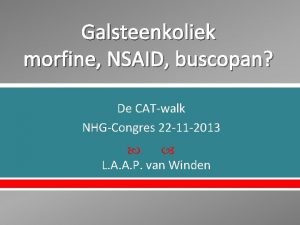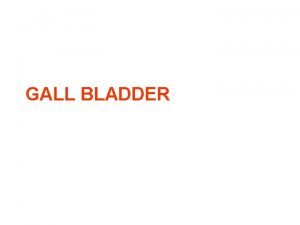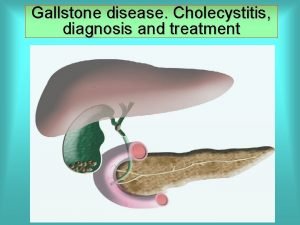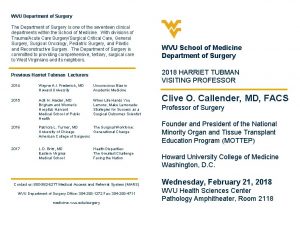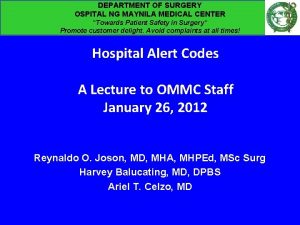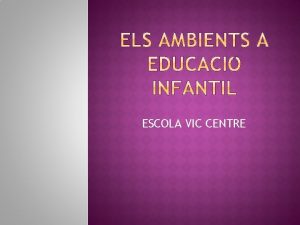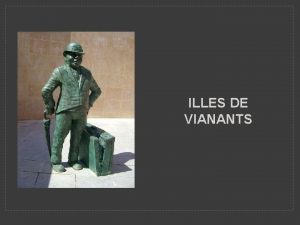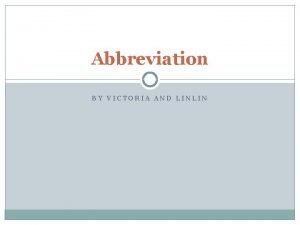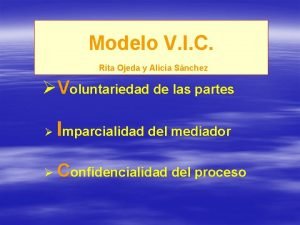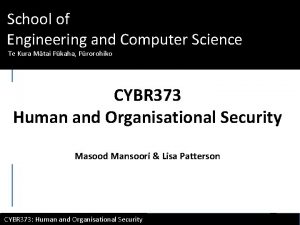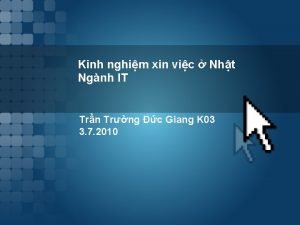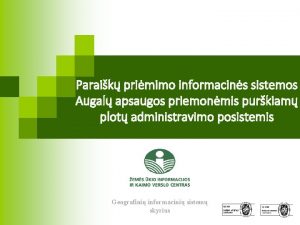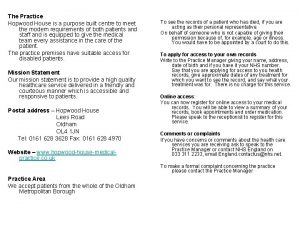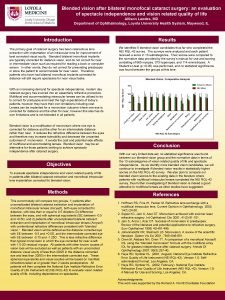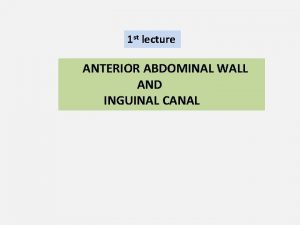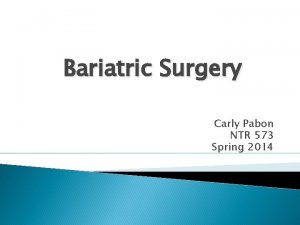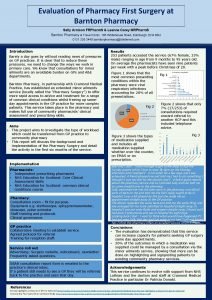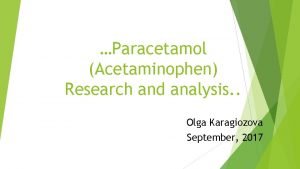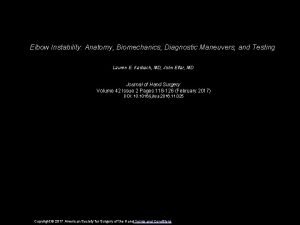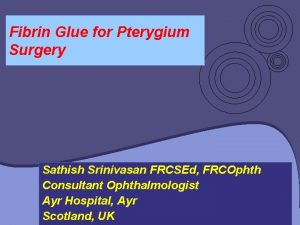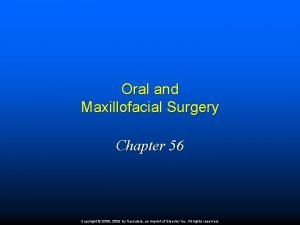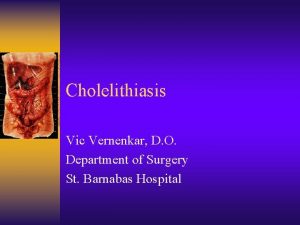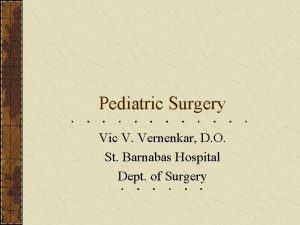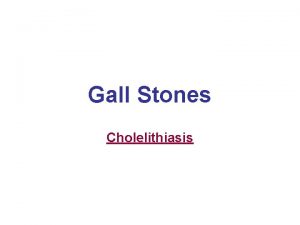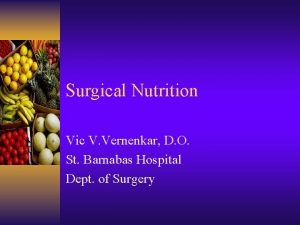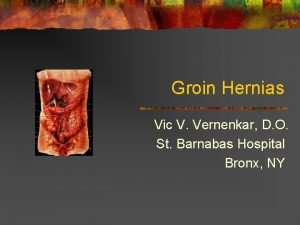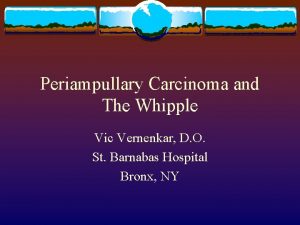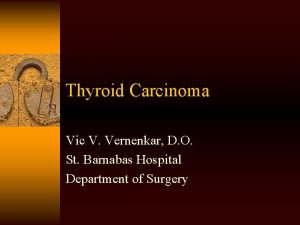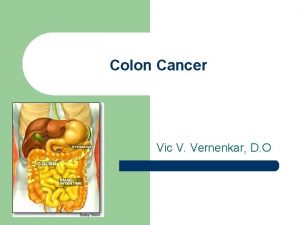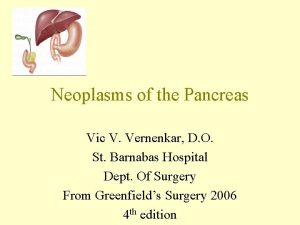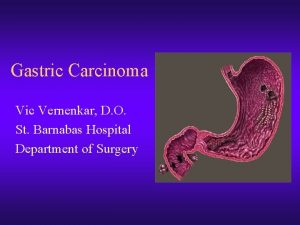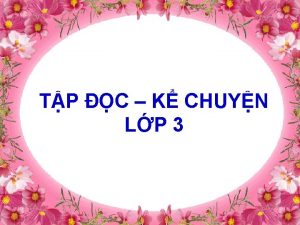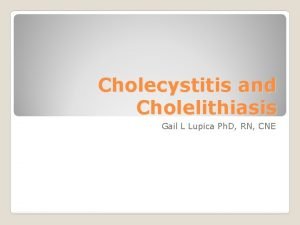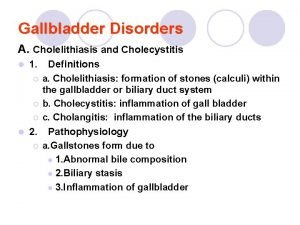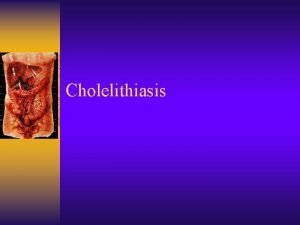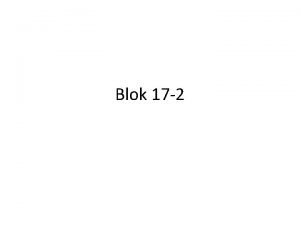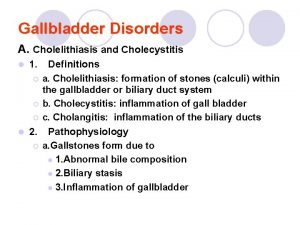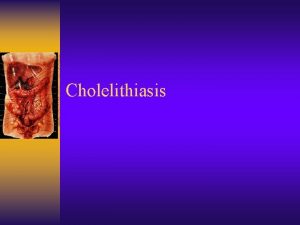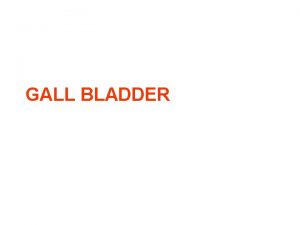Cholelithiasis Vic Vernenkar D O Department of Surgery









































- Slides: 41

Cholelithiasis Vic Vernenkar, D. O. Department of Surgery St. Barnabas Hospital

A Cause For Pain

Background ¨ Presence of gallstones in the gallbladder. ¨ Spectrum ranges from asymptomatic, colic, cholangitis, choledocholithiasis, cholecystitis ¨ Colic is a temporary blockage, cholecystitis is inflammation from obstruction of CBD or cystic duct, cholangitis is infection of the biliary tree.

Anatomy

Pathophysiology ¨ Three types of stones, cholesterol, pigment, mixed. ¨ Formation of each types is caused by crystallization of bile. ¨ Cholesterol stones most common. ¨ Bile consists of lethicin, bile acids, phospholipids in a fine balance. ¨ Impaired motility can predispose to stones.

Pathophysiology ¨ Sludge is crystals without stones. It may be a first step in stones, or be independent of it. ¨ Pigment stones (15%) are from calcium bilirubinate. Diseases that increase RBC destruction will cause these. Also in cirrhotic patients, parasitic infections.

Harvest Time

Frequency ¨ US: affected by race, ethnicity, sex, medical conditions, fertility. 20 million have GS. Every year 1 -2% of people develop them. Hispanics are at increased risk. ¨ Internationally: 20% of women, 14% of men. Patients over 60 prevalence was 12. 9% for men, 22. 4% for women.

Morbidity/Mortality ¨ Every year 1 -3% of patients develop symptoms. ¨ Asymptomatic GS are not associated with fatalities. ¨ Morbidity and mortality is associated only with symptomatic stones.

Race ¨ Highest in fair skinned people of northern European descent and in Hispanic populations. ¨ High in Pima Indians (75% of elderly). In addition Asians with stones are more likely to have pigmented stones than other populations. ¨ African descent with Sickle Cell Anemia.

Sex ¨ More common in women. Etiology may be secondary to variations in estrogen causing increased cholesterol secretion, and progesterone causing bile stasis. ¨ Pregnant women more likely to have symptoms. ¨ Women with multiple pregnancies at higher risk ¨ Oral contraceptives, estrogen replacement tx.

Age ¨ It is uncommon for children to have gallstones. If they do, its more likely that they have congenital anomalies, biliary anomalies, or hemolytic pigment stones. ¨ Incidence of GS increases with age 1 -3% per year.

History ¨ 3 clinical stages: asymptomatic, and with complications (cholecystitis, cholangitis, CBD stones). ¨ Most (60 -80%) are asymptomatic ¨ A history of epigastric pain with radiation to shoulder may suggest it. ¨ A detailed history of pattern and characteristics of symptoms as well as US make the diagnosis.

History ¨ Most patients develop symptoms before complications. ¨ Once symptoms occur, severe symptoms develop in 3 -9%, with complications in 1 -3% per year, and a cholecystectomy rate of 3 -8% per year. ¨ Indigestion, bloating, fatty food intolerance occur in similar frequencies in patients without gallstones, and are not cured with cholecystectomy.

History ¨ Best definition of colic is pain that is severe in epigastrium or RUQ that last 1 -5 hrs, often waking patient at night. ¨ In classic cases pain is in the RUQ, however visceral pain and GB wall distension may be only in the epigastric area. ¨ Once peritoneum irritated, localizes to RUQ. Small stones more symptomatic.

Physical ¨ Vital signs and physical findings in asymptomatic cholelithiasis are completely normal. ¨ Fever, tachycardia, hypotension, alert you to more serious infections, including cholangitis, cholecystitis. ¨ Murphy’s sign

Causes ¨ Fair, fat, female, fertile of course. ¨ High fat diet ¨ Obesity ¨ Rapid weight loss, TPN, Ileal disease, NPO. ¨ Increases with age, alcoholism. ¨ Diabetics have more complications. ¨ Hemolytics

Differentials ¨ AAA ¨ Appendicitis ¨ Cholangitis, cholelithiasis ¨ Diverticulitis ¨ Gastroenteritis, hepatitis ¨ IBD, MI, SBO ¨ Pancreatitis, renal colic, pneumonia

Workup ¨ Labs with asymptomatic cholelithiasis and biliary colic should all be normal. ¨ WBC, elevated LFTS may be helpful in diagnosis of acute cholecystitis, but normal values do not rule it out. ¨ Study by Singer et al examined utility of labs with chole diagnosed with HIDA, and showed no difference in WBC, AST, ALT Bili, and Alk Phos, in patients diagnosed and those without.

Workup ¨ Elevated WBC is expected but not reliable. ¨ In retrospective study, only 60% of patients with cholecytitis had a WBC greater than 11, 000. A WBC greater than 15, 000 may indicate perforation or gangrene. ¨ ALT, AST, AP more suggestive of CBD stones ¨ Amylase elevation may be GS pancreatitis.

Imaging Studies ¨ US and Hida best. Plain x-rays, CT scans ERCP are adjuncts. ¨ X-rays: 15% stones are radiopaque, porcelain GB may be seen. Air in biliary tree, emphysematous GB wall. ¨ CT: for complications, ductal dilatation, surrounding organs. Misses 20% of GS. Get if diagnosis uncertain.

CT Scan

Plain Films

Imaging ¨ Ultrasound is 95% sensitive for stones, 80% specific for cholecystitis. It is 98% sensitive and specific for simple stones. ¨ Wall thickening (2 -4 mm) false positives! ¨ Distension ¨ Pericholecystic fluid, sonographic Murphy’s. ¨ Dilated CBD(7 -8 mm).

Ultrasound

Ultrasound

Imaging ¨ Hida scan documents cystic duct patency. ¨ 94% sensitive, 85% specific ¨ GB should be visualized in 30 min. ¨ If GB visualized later it may point to chronic cholecystitis. ¨ CBD obstruction appears as non visualization of small intestine. ¨ False positives, high bilirubin.

Hida

Imaging ¨ ERCP is diagnostic and therapeutic. ¨ Provides radiographic and endoscopic visualization of biliary tree. ¨ Do when CBD dilated and elevated LFTs. ¨ Complications include bleeding, perforation, pancreatitis, cholangitis.

ERCP

Emergency Department Care ¨ Suspect GB colic in patients with RUQ pain of less than 4 -6 h duration radiating to back. ¨ Consider acute cholecystits in those with longer duration of pain, with or without fever. Elderly and diabetics do not tolerate delay in diagnosis and can proceed to sepsis.

Emergency Department Care ¨ After assessment of ABCs, perform standard IV, pulse oximetry, EKG, and monitoring. Send labs while IV placed, include cultures if febrile. ¨ Primary goal of ED care is diagnosis of acute cholecystitis with labs, US, and or Hida. Once diagnosed, hospitalization usually necessary. Some treated as OP.

Emergency Department Care ¨ In patients who are unstable or in severe pain, consider a bedside US to exclude AAA and to assist in diagnosis of acute cholecystitis. ¨ Replace volume with IVF, NPO, +/- NGT. ¨ Administer pain control early. A courtesy call to surgery may give them time to examine without narcotics.

Consults ¨ Historically cholecystits was operated on emergently which increased mortality. ¨ Surgical consult is appropriate, and depending on the institution, either medicine or surgery may admit the patients for care. ¨ Get GI involved early if suspect CBD obstruction.

Medications ¨ Anticholinergics such as Bentyl (dicyclomine hydrochloride)to decrease GB and biliary tree tone. (20 mg IM q 4 -6). ¨ Demerol 25 -75 mg IV/IM q 3 ¨ Antiemetics (phenergan, compazine). ¨ Antibiotics (Zosyn 3. 375 g IV q 6) need to cover Ecoli(39%), Klebsiella(54%), Enterobacter(34%), enterococci, group D strep.

Further Inpatient Care ¨ Cholecystectomy can be performed after the first 24 -48 h or after the inflammation has subsided. Unstable patients may need more urgent interventions with ERCP, percutaneous drainage, or cholecystectomy. ¨ Lap chole very effective with few complications (4%). 5% convert to open. In acute setting up to 50% open.

Laparoscopic Cholecystectomy

Laparoscopic Cholecystectomy

Further Outpatient Care ¨ Afebrile, normal VS ¨ Minimal pain and tenderness. ¨ No markedly abnormal labs, normal CBD, no pericholecystic fluid. ¨ No underlying medical problems. ¨ Next day follow-up visit. ¨ Discharge on oral antibiotics, pain meds.

Complications ¨ Cholangitis, sepsis ¨ Pancreatitis ¨ Perforation (10%) ¨ GS ileus (mortality 20% as diagnosis difficult). ¨ Hepatitis ¨ Choledocholithiasis

Prognosis ¨ Uncomplicated cholecystitis as a low mortality. ¨ Emphysematous GB mortality is 15% ¨ Perforation of GB occurs in 3 -15% with up to 60% mortality. ¨ Gangrenous GB 25% mortality.
 Cholelithiasis nhg
Cholelithiasis nhg Chronic calculous cholecystitis
Chronic calculous cholecystitis Perbedaan cholelithiasis dan cholecystitis
Perbedaan cholelithiasis dan cholecystitis Kode icd 10 obesitas akibat pil kb
Kode icd 10 obesitas akibat pil kb Asterixis
Asterixis Wvu department of surgery
Wvu department of surgery Ospital ng maynila directory
Ospital ng maynila directory Vic ts
Vic ts Hpe curriculum vic
Hpe curriculum vic Escola vic centre
Escola vic centre Acces temporal illa vianants vic
Acces temporal illa vianants vic Abbreviation of victoria
Abbreviation of victoria Anne doblesh
Anne doblesh Nick the vic
Nick the vic Teknik dribble dalam permainan bola basket
Teknik dribble dalam permainan bola basket Vic curriculum progression points
Vic curriculum progression points Eal continuum victoria
Eal continuum victoria Asset tracking victoria
Asset tracking victoria Vic rayner wikipedia
Vic rayner wikipedia Berendsen fluid power brisbane
Berendsen fluid power brisbane Vuw myalloactor
Vuw myalloactor Critical and creative thinking vic curriculum
Critical and creative thinking vic curriculum Music curriculum victoria
Music curriculum victoria Edupay.eduweb.vic.gov.au
Edupay.eduweb.vic.gov.au Xin vic
Xin vic Tsoa vic
Tsoa vic Vic pappas
Vic pappas Victorian curriculum intercultural capability
Victorian curriculum intercultural capability Vic fontaine songs
Vic fontaine songs Vic prisijungimas
Vic prisijungimas Hopwood house doctors
Hopwood house doctors What should happen if a nobleman dies during surgery?
What should happen if a nobleman dies during surgery? Banobagi dr lee
Banobagi dr lee Blended vision
Blended vision Camper fascia
Camper fascia Bariatric surgery pes statement
Bariatric surgery pes statement Plastic surgery pharmacy
Plastic surgery pharmacy Effects of paracetamol
Effects of paracetamol Journal of hand surgery
Journal of hand surgery Intermediate-risk surgery list
Intermediate-risk surgery list Sathish srinivasan
Sathish srinivasan Chapter 56 oral and maxillofacial surgery multiple choice
Chapter 56 oral and maxillofacial surgery multiple choice
